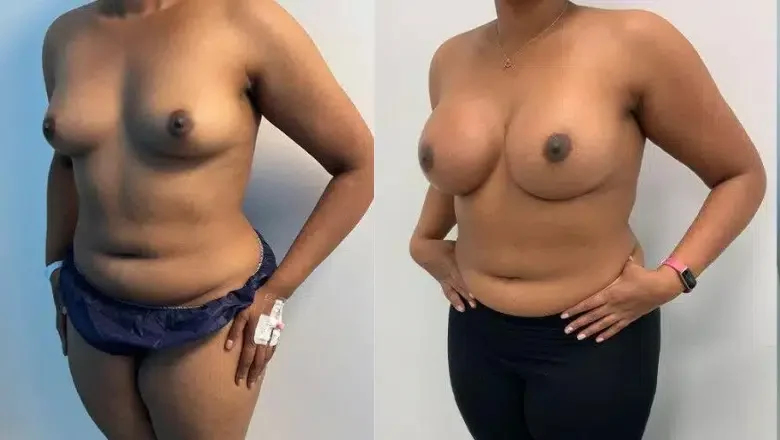Breast augmentation is a timeless surgical option that welcomes individuals across a wide age spectrum. Whether you’re over 50 or in your younger years, such as your 20s and 30s, this procedure can yield exceptional results, enhancing breast appearance significantly.
Addressing Age-Related Changes in Breasts
For many older women, the primary concern often revolves around the natural ageing process that alters breast aesthetics. Over the years, it’s common for women to notice a decrease in breast volume and elasticity, leading to what many describe as saggy breasts. These changes are not just due to ageing but are also influenced by hormonal shifts brought on by pregnancy and menopause, contributing further to the drooping appearance of breasts.
RELATED: Breast Augmentation For Older Women
Breast augmentation offers a rejuvenating effect. By focusing on the upper pole or section of the breast, the procedure aims to restore fullness and provide a more youthful contour. The addition of volume and improved shape not only enhances the overall appearance but can also boost self-confidence.
Customising Breast Enhancement
Age can also impact the size of the breasts, making them appear smaller over time. Some individuals might find that breast implants placed in earlier years no longer complement their current lifestyle or aesthetic preferences. At Centre for Surgery, our expert plastic surgeons specialise in tailoring breast augmentation procedures to fit your unique needs and desires. Whether you’re looking to replace old implants with a new style or size, or if it’s your first time considering this procedure, our team is here to guide you through your options and help you achieve the look that best suits your body and goals.
Suitability for Breast Augmentation in Your 50s and 60s
Deciding on breast augmentation later in life, such as in your 50s or 60s, involves considerations that focus more on health than age itself. At Centre for Surgery, we believe age should not be a barrier to enhancing your appearance through breast augmentation, provided that you meet certain health criteria to ensure a safe and successful procedure.
Health Requirements for Breast Augmentation
The key to determining your suitability for breast augmentation is your overall health status. Our surgeons will undertake a thorough assessment of your health to ensure that you are a good candidate for surgery. Here are the essential health criteria you need to meet:
- General Health: Patients must be in good health, which helps facilitate smoother surgery and recovery.
- Smoking: If you smoke, you will need to stop in the weeks before and after your surgery. Smoking can significantly impair healing, increasing the risk of complications.
- Medical History Review: Make sure you disclose your complete medical history. Conditions such as cardiovascular disease and type 2 diabetes may affect your suitability for surgery.
- Medication Disclosure: Any medications you are currently taking must be discussed to avoid any potential interference with the surgical process.
- Mammogram: We typically recommend that women over 50 undergo a recent mammogram before proceeding with breast augmentation. This precaution helps ensure there are no underlying conditions that could complicate the surgery.
Recovery Considerations for Older Adults
While breast augmentation is safe and effective for older adults, it’s important to note that recovery may take slightly longer compared to younger patients. The ageing process can slow down the body’s natural healing capabilities. Additionally, factors like smoking can further diminish the body’s ability to regenerate tissue, thus prolonging recovery and increasing the risk of post-surgical complications.
Addressing Breast Sagging: Considerations for Uplift and Augmentation
Breast sagging is a common concern, particularly as women age. It’s a natural change that can affect self-confidence and comfort. If you’re considering surgical options to rejuvenate the appearance of your breasts, it’s important to understand the most effective treatments available, especially when dealing with mature, sagging breasts.
What Causes Breast Sagging?
Breast sagging, or ptosis, typically occurs due to a combination of factors, including ageing, gravity, hormonal changes, and the effects of pregnancy and breastfeeding. Over time, these factors can lead to a loss of skin elasticity and changes in breast tissue, resulting in a drooping appearance.
Options for Addressing Sagging Breasts
When considering breast augmentation, it’s crucial to evaluate whether a combined approach with both breast uplift (mastopexy) and augmentation is necessary. Here’s what the combined procedure involves:
- Breast Uplift (Mastopexy): This surgical procedure addresses sagging by removing excess skin and, often, repositioning the areola and nipple to a more elevated location. The remaining breast skin is tightened, which results in a more lifted and youthful breast contour.
- Breast Augmentation with Implants: Adding implants during the uplift procedure can also increase breast size, enhancing overall breast shape and volume. This is particularly beneficial for achieving a fuller look while correcting sagging.
Why Combining Procedures Might Be Necessary
Choosing to have implants alone when your breasts have already begun to sag might not yield the results you desire. The added weight of implants can potentially cause further sagging if the existing breast tissue and skin are not capable of supporting the new volume. This is why a mastopexy might be recommended in conjunction with augmentation.
Implants are not a standalone solution for sagging breasts because they do not address the excess skin or the lowered position of the nipple and areola. A lift is often necessary to achieve a truly rejuvenated appearance.
Considering a Breast Uplift for Sagging Breasts
If sagging is your main concern, a breast uplift (mastopexy) might be the ideal procedure for you. This surgery addresses sagging by removing excess skin and tightening the remaining skin to lift and firm the breasts. Here’s what to consider:
- Procedure Details: The uplift involves excising excess skin, tightening the remaining skin, and possibly repositioning the nipple and areola to enhance the breast’s appearance.
- Ideal Candidates: Suitable for those content with their breast size but seeking to improve shape and position for a more youthful look.
- Benefits: Offers a natural look, long-lasting results, improved shape, and increased comfort by alleviating issues like skin irritation under the breast.
Breast Surgery and Mammograms
For many older individuals who have undergone breast surgery, the prospect of having a mammogram can be a source of concern. However, it’s important to understand that mammograms are entirely safe for patients with breast implants. The radiographers who perform these procedures are well-versed in using specialised techniques that ensure the presence of implants does not hinder the radiologist’s ability to thoroughly examine and detect any potential issues.
Breast implants are designed to be durable and should not rupture or shift position as a result of a mammogram. It’s worth noting, though, that breast implants generally have a lifespan of about ten years. While this doesn’t necessarily mean they must be replaced after this period, the ageing process can make the outer shell of the implant more susceptible to rupturing. Therefore, it is crucial to maintain regular follow-up appointments with your plastic surgeon. This is especially important if your implants have been in place for more than a decade, as it allows for ongoing assessment and management to ensure continued safety and effectiveness.












